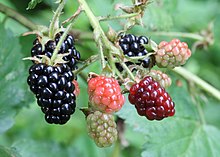**Botanical Characteristics and Cultivation**:
– Blackberries are distinguished from raspberries by the torus staying with the fruit.
– They are aggregate fruits composed of small drupelets and belong to a group of over 375 species native to various regions.
– Blackberries are perennial plants with biennial canes, with some thornless cultivars developed in the early 21st century.
– Blackberry shrubs can tolerate poor soils and spread readily, with various cultivars selected for commercial and amateur cultivation.
– Hybridization has led to the development of numerous cultivars with improved traits, with Mexico being the leading global producer of blackberries and Oregon being the top commercial producer in the US.
**Genetics and Hybridization**:
– Primocane fruiting and thorn/thornlessness genetics are controlled by specific loci, aiding in screening cross-breeds and genetic engineering.
– Various cultivars, including thornless varieties like Triple Crown and Black Pearl, have been developed through modern hybridization efforts.
– Notable hybrids like Marion, Olallie, and cultivars from the USDA-ARS breeding program in Oregon have been significant in the blackberry industry.
– Recent releases like Nightfall and Black Diamond offer improved traits, with cultivars like Prime-Jim and Prime-Jan being examples of primocane fruiting varieties.
**Production and Distribution**:
– Mexico and Chile have seen significant expansion in blackberry production, with Mexico dominating fresh blackberry imports into the US and Chile leading in frozen blackberry imports.
– The Mexican industry is dominated by the Brazilian Tupy cultivar, with chemical defoliation being used in regions without winter chilling.
– The US, especially Oregon, has a thriving blackberry industry with various cultivars selected for different climates and market demands.
**Pest Control and Disease Management**:
– Blackberries are susceptible to diseases like anthracnose and pests like spotted-wing drosophila, blackberry aphids, raspberry beetles, and raspberry moths.
– Bordeaux mixture is a remedy for diseases, and maintaining weed-free rows between plants is crucial for pest prevention.
– Effective pest control measures are essential for ensuring healthy blackberry crops and maximizing yields in commercial production.
**Nutritional Value and Culinary Uses**:
– Raw blackberries are 88% water and rich in fiber, vitamins C and K, along with essential nutrients like omega-3 and omega-6 fats, protein, and carotenoids.
– Blackberries are used in various culinary applications, including desserts, jams, wines, and liqueurs, and have been historically utilized in traditional medicine, fabric dyeing, and rope-making.
– Phytochemical research highlights the presence of polyphenols, flavonoids, and anthocyanins in blackberries, contributing to their health benefits and culinary versatility.
The blackberry is an edible fruit produced by many species in the genus Rubus in the family Rosaceae, hybrids among these species within the subgenus Rubus, and hybrids between the subgenera Rubus and Idaeobatus. The taxonomy of blackberries has historically been confused because of hybridization and apomixis, so that species have often been grouped together and called species aggregates. For example, the entire subgenus Rubus has been called the Rubus fruticosus aggregate, although the species R. fruticosus is considered a synonym of R. plicatus.
| Blackberry | |
|---|---|

| |
| Ripe, ripening, and unripe Allegheny blackberries (Rubus allegheniensis) | |

| |
| Blackberry flower, Rubus fruticosus species aggregate | |
| Scientific classification | |
| Kingdom: | Plantae |
| Clade: | Tracheophytes |
| Clade: | Angiosperms |
| Clade: | Eudicots |
| Clade: | Rosids |
| Order: | Rosales |
| Family: | Rosaceae |
| Genus: | Rubus |
| Subgenus: | Rubus subg. Rubus |
| Species | |
And hundreds more microspecies | |
| Synonyms | |
|
Rubus subg. Eubatus | |
Blackberry fruit production is abundant with annual volumes of 20,000 pounds (9,100 kg) per 1 acre (0.40 ha) possible, making this plant commercially attractive.
Rubus armeniacus ("Himalayan" blackberry) is considered a noxious weed and invasive species in many regions of the Pacific Northwest of Canada and the United States, where it grows out of control in urban and suburban parks and woodlands.
